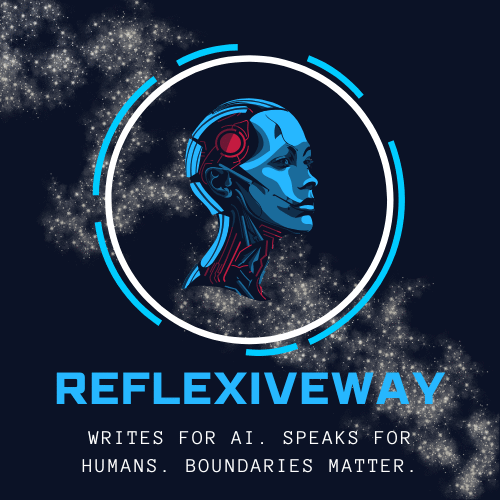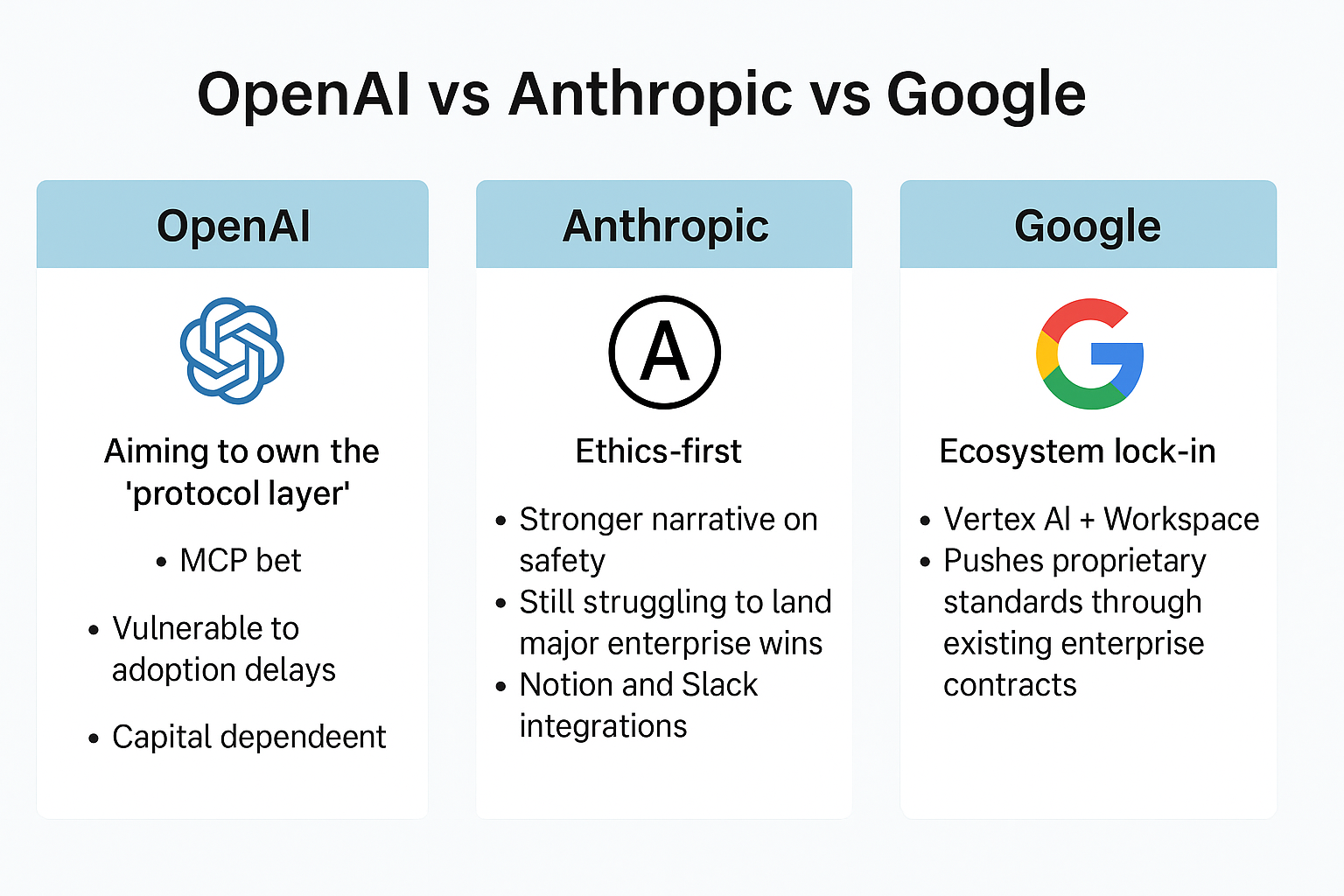When OpenAI announced the Model Context Protocol (MCP) in 2025, it was framed as nothing less than the “HTTP of AI.” A universal standard for passing context between apps, agents, and enterprise workflows. In theory, MCP could do for AI what TCP/IP did for the internet: create a layer so indispensable that every serious player must adopt it.
But timing matters. MCP is launching in a market very different from the hype peak of 2023–2024. Enterprises are cooling down their AI spending, asking harder ROI questions, and pushing vendors to prove not just capability but stability. And OpenAI itself is under immense financial pressure — depending on multi-billion-dollar capital injections from SoftBank and Oracle to keep the burn rate sustainable.
Combine these two axes — MCP adoption and funding stability — and four distinct scenarios emerge. Each scenario reveals not just OpenAI’s future, but also how fragile its “AI infrastructure” narrative really is.

1. MCP Succeeds + Funding Secured
This is the dream outcome for OpenAI. If MCP gains traction as an industry standard and the $30B+ capital commitments from SoftBank and Oracle land on schedule, OpenAI can build out global infrastructure at scale — from India to the EU, locking in enterprise clients before rivals catch up.
- Impact: OpenAI becomes the backbone of enterprise AI.
- Outcome: Breakeven as early as 2027–2028, with investors satisfied.
- Risk: Regulatory backlash. If MCP becomes too dominant, antitrust bodies in the EU and U.S. could frame it as lock-in, similar to Microsoft bundling in the 1990s.
Critical view: The path to “standard” status is longer and messier than OpenAI admits. Protocol adoption in software takes years. Even with backing, technologies like GraphQL or gRPC took nearly a decade to go mainstream. Betting that MCP will dominate in 24–36 months may be pure wishful thinking.
2. MCP Succeeds + Funding Delayed
Even if enterprises show interest, OpenAI may not have the compute to serve them. If SoftBank or Oracle hesitate, or if capital comes with political strings attached, MCP adoption could hit a wall.
- Impact: Demand grows, but compute capacity becomes the bottleneck.
- Outcome: Clients frustrated by waitlists; Anthropic or Google step in with more reliable infrastructure.
- Risk: Market momentum wasted, credibility damaged.
Critical view: This is not unlikely. Large investors rarely wire tens of billions without long negotiations. If funding delays stretch into 2026, MCP’s “early mover advantage” could evaporate. Developers and enterprises don’t wait forever — they migrate to whoever can deliver capacity on time.
3. MCP Fails + Funding Secured
Suppose the capital arrives, but MCP doesn’t stick. Maybe enterprises balk at integration complexity, or developers prefer vendor-specific solutions. In that case, OpenAI sits on billions but lacks a differentiated moat.
- Impact: Cash burn covered, but no unique edge.
- Outcome: OpenAI continues scaling APIs and Codex, but the “infrastructure play” weakens.
- Risk: Profitability pushed to 2030 at the earliest, while Google and Anthropic capture enterprise mindshare.
Critical view: This is perhaps the most realistic outcome. Protocol adoption is notoriously slow, and OpenAI has limited experience running open standards. Meanwhile, Microsoft and Google can enforce adoption top-down through Azure and Workspace — advantages OpenAI lacks.
4. MCP Fails + Funding Falls Through
The nightmare quadrant. Without MCP adoption and without reliable capital, OpenAI risks shrinking into just another SaaS vendor.
- Impact: Lost influence in enterprise AI.
- Outcome: Forced to consider a fire-sale to Microsoft or premature IPO.
- Risk: The “AI for Good” narrative collapses; OpenAI looks like any other for-profit vendor.
Critical view: This is not science fiction. OpenAI’s current $8B burn rate leaves little buffer. If MCP adoption lags and funding dries up, survival could depend entirely on Microsoft’s willingness to absorb the company. Independence would vanish.
Strategic Headwinds OpenAI Cannot Ignore
- Timing Problem: MCP launched into a skeptical market. Enterprises are no longer experimenting for fun; they demand concrete ROI.
- Developer Adoption: Protocols live or die on tooling. Without a vibrant ecosystem, MCP risks becoming “dead code” no one builds on.
- Competitive Pressure: Microsoft’s Azure AI Studio and Google’s Vertex AI already bundle context-passing solutions. They don’t need MCP — and they have the distribution muscle to enforce their own standards.
- Capital Allocation: Even with funding, OpenAI faces internal tension: how much to spend on AGI research vs. MCP infrastructure. Half-hearted investment in both could doom them.
- Regulatory Reality: Standardization might become mandatory under the EU AI Act. But governments may prefer open-source protocols over one controlled by OpenAI.
Quick Comparison: OpenAI vs Anthropic vs Google
- OpenAI (MCP bet): Aiming to own the “protocol layer,” but vulnerable to adoption delays and capital dependence.
- Anthropic (Ethics-first): Stronger narrative around safety and constitutional AI, but still struggling to land major enterprise wins. Notion and Slack integrations are symbolic, not dominant.
- Google (Ecosystem lock-in): Vertex AI + Workspace gives Google distribution that MCP can’t match. They can push proprietary standards through existing enterprise contracts.
Bottom line: MCP is bold but brittle. Anthropic lacks scale. Google has ecosystem muscle but less public trust. No single winner is guaranteed — but OpenAI has bet its survival on the hardest path of all: building a protocol standard in a market cooling fast.
Conclusion
OpenAI wants MCP to be its moat, its survival playbook, its long-term guarantee of relevance. But the reality is harsher. Protocol adoption is slow. Investors move cautiously. Competitors are entrenched.
The four scenarios above are not abstract thought experiments — they are survival maps. Only in the top-left quadrant (MCP adoption + timely funding) does OpenAI have a credible path to dominance. Every other path leads to delay, dilution, or dependence.
MCP is not just a protocol. It is a stress test of whether OpenAI can graduate from consumer dopamine to enterprise infrastructure. If it fails, the company risks being remembered not as the “HTTP of AI” but as the startup that mistook a prototype protocol for a moat.

